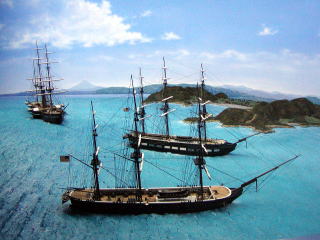 |
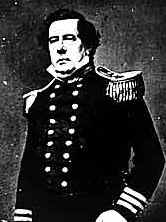 |
| Black Ships (models) | Matthew C. Perry (1794-1858) |
(See Handout no.3)
Since 1639, the Bakufu government banned any foreign contact except in a very limited way at Nagasaki's Dejima (tiny artificial island) under strict official control (in other words, the Bakufu monopolized foreign trade). Korea and Ryukyu (Okinawa) had diplomatic relations with Japan, while Chinese and Dutch merchants were allowed to trade with Japan. All other transactions were strictly prohibited. No Japanese were allowed to go abroad or come home from abroad. Thus the only channel for receiving Western knowledge (mainly medical and scientific information) was through Dutch books and products.
But from the end of the 18th century, foreign ships began to approach Japan with an intention to trade. The Russians and the British were particularly eager but the Bakufu refused them. The news of the Opium War (1840-42), in which the British defeated China, took possession of Hong Kong and forced China to open ports, was a big shock to the Bakufu.
 |
 |
| Black Ships (models) | Matthew C. Perry (1794-1858) |
Finally, four American military ships ("Black Ships") under Commodore Matthew C. Perry entered Tokyo Bay in 1853. The Bakufu was forewarned about their coming but did nothing to prevent it. This was a well-planned mission in which Perry had carefully designed the negotiating strategy with Japan. He was convinced that the show of force, not peaceful diplomacy, was most effective. Displaying and firing cannons, Perry demanded a "friendship" treaty to use Japanese ports. Perry left, saying he would return to hear the answer in the following year. The entire Japan was thrown into chaos and a fierce debate began as to whether Japan should open its ports or fight foreigners. In the next year when Perry returned, the Bakufu signed the friendship treaty with the US (similar treaties were also concluded with the Europeans). It would have been politically better to hear opinions from various domestic groups (especially strong daimyos) before signing, but the Bakufu did not do that.
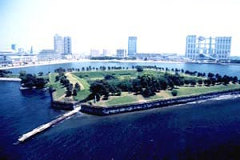 |
|
Odaiba no.3 viewed from Rainbow Bridge. This is a park and you can actually visit it. Odaiba Island in the back did not exist when Perry came |
In 1858, the Bakufu asked for the Emperor's permission to sign full commercial treaties with the major powers but it was not granted. The Bakufu signed them without imperial permission and was severely criticized by opposing groups. Naosuke Ii (Bakufu high official, something like prime minister) responded by punishing and executing the opposition. However, Ii was assassinated a year later by samurais angry with the Bakufu's oppressive policy (1859).
Odaiba means (Bakufu's) coastal fort equipped with cannons. You can see the two remaining odaiba (tiny square-shaped artificial islands) from Yurikamome, near Rainbow Bridge, off Shinagawa. After the arrival of Black Ships, the Bakufu hurriedly built them for maritime defense. Apparently, these forts were not enough to stop the Americans.
With these treaties, foreign diplomats and merchants began to live in Japan. However, they were permitted to live only in designated foreign settlements. The most important foreign settlement was Yokohama, a city newly created for this purpose. They were not allowed to travel freely or mingle with the the general public. [For the photos of early Yokohama and other scenes, see Meiji Photo Gallery.]
The opening of Japanese ports led to significant social and economic changes:
--Foreigners brought new ideas, technology, industry and systems, and the Japanese began to absorb them very rapidly. But they were also afraid of Europeans' superior military power.--Silk and tea suddenly found huge overseas markets. The rising output and soaring prices of these commodities enriched farmers who produced them.
--Farmers began to buy imported clothes made in England (previously, they used to wear homemade or secondhand clothes only).
--A new merchant class ("Yokohama merchants") emerged to link domestic producers and markets with foreign merchants (who could not travel outside the foreign settlement).
--Inflation surged, impoverishing samurais and urban population. The entire price structure was transformed after the port opening. Old industries and traditional merchants declined and new ones emerged.
The commercial treaties the Bakufu signed with the West were unequal treaties because (i) Japan had no right to decide tariffs; and (ii) the Japanese court could not judge foreign criminals in Japan. The opposition blamed the Bakufu for signing defective treaties. They also criticized the Bakufu for economic turmoil (including inflation) and yielding to foreign pressure without national consensus or imperial permission. The Japanese tariffs were set uniformly at around 5% until 1899 when Japan began to regain the tariff rights.
After the opening of ports, severe political fights ensued about 15 years. Details are too complicated to describe here, but the key issues were as follows:
(1) Open door policy versus anti-foreigner nationalism
(2) Respecting the emperor versus supporting the Bakufu
(3) Strong hans (especially Satsuma and Choshu) fighting for political power
Anti-foreigner nationalism was very strong at first, but people gradually realized the impossibility of repelling the foreigners by force; the West was too modern and strong. The political fight finally centered on how to remove the Bakufu and establish a new government. In a series of relatively minor fighting (one of the fiercest battles was fought where Ueno Park now stands), the Bakufu forces were defeated and the new Meiji government was established in 1868. The Emperor moved from Kyoto to Edo, which was renamed Tokyo (meaning eastern capital).
The Meiji government was formed and run by young samurais from strong hans in Western Japan (especially Satsuma, Choshu, Tosa, Hizen) and a few influential noblemen. The emperor was elevated to the head of state for legitimacy and as a unifying symbol of the new regime. The Meiji government had a very clear and determined policy objective: rapid Westernization and modernization of Japan. At first, the biggest external challenge was to avoid being colonized by the West. But this fear soon subsided in the early Meiji period as Japan began to aggressively absorb Western systems and technology while retaining national unity and identity. For the rest of Meiji and beyond, the top national priority was to catch up with the West in every aspect of civilization, i.e., to become a "first-class nation," as quickly as possible.
After a "long peaceful sleep" (international isolation) in the Edo period, Japan suddenly discovered that Europeans and Americans were greatly advanced in technology and industry, and Japan was a backward agricultural country. This was a big shock to Japan. The acute recognition of backwardness and lost pride was the psychological driving force behind Japan's industrialization during the Meiji period.
The national slogan was fukoku kyohei which means "rich country, strong military."
In order to modernize Japan, the Meiji government had three goals:
--Industrialization (economic modernization)
--Establishing a national constitution and parliament (political modernization)
--External expansion (military modernization)
These were shared goals among all politicians, officials and even people. While there were many political fights among Meiji leaders, they fought over the method and sequencing of achieving these goals. Virtually everyone agreed on the importance of these three goals. For example, a politician might oppose his rival who advocated the invasion of Korea, but when the rival was ousted, the same politician might send troops to Taiwan (this actually happened in 1873-74). Similar flip-flop of positions were also observed over many political and economic policies.
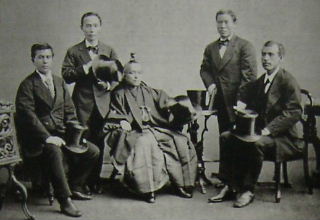 |
|
Iwakura mission in San Francisco. Tomomi Iwakura (mission chief, in Japanese dress) at center. Others are in Western clothes. Okubo is sitting on the right. |
The big problem in early Meiji was resistance from conservatists who opposed radical reforms. The previous samurai class, now deprived of rice salary and privilege of carrying swords, was particularly unhappy with the new government (which was established ironically by young samurais). But step by step, the new government succeeded in reducing their influence and consolidating power. It abolished the samurai class (and gave them government bonds in compensation, whose value rapidly depreciated under inflation). The han system was replaced by a centralized government and prefectures with governors appointed by Tokyo. A new land tax (levied on land value) replaced the old rice tax (levied on annual yield or its average).
In 1871-73, a high-level official mission, the Iwakura Mission, including about half the cabinet ministers, was sent to the US and Europe for nearly two years. The total mission members were initially 107, including students dispatched abroad. Its purposes were to (i) conduct preliminary negotiations for revising the unequal treaties; and (ii) study Western technology and systems. They failed in the first objective because the West would not treat Japan equally as long as its institutions were "backward." But the officials succeeded in gaining insights in their second objective. The mission was warmly welcomed wherever they went.
Among the members of the Iwakura Mission, Toshimichi Okubo was particularly impressed with Western technology. Returning to Japan, Okubo vigorously promoted industrialization as the minister of finance (later, as the minister of interior). His policies included hiring foreign advisors, hosting domestic industrial exhibition, and building roads, railroads, agricultural research centers, and so on. Many state-owned model factories were established in silk spinning, shipbuilding and mining (most mines were rehabilitated mines from the Edo period). New systems such as metric weights and measures, Western calendar, new monies, banking, joint stock companies and so forth were introduced. Okubo was assassinated in 1878 but his supporters, especially Kiyotaka Kuroda and Shigenobu Okuma, continued his policy.
Most SOEs were commercially unsuccessful, but they had strong demonstration effects. They also trained many Japanese engineers who later worked in or established other factories. Subsequently, these SOEs were privatized (except military ones). But since they were sold cheaply to influential businessmen (such as Tomoatsu Godai--see below), it caused a political scandal in 1881. After privatization, some of the loss-making enterprises were restored to profitability through restructuring and new investment.
The government sometimes confused businesses with inconsistent policies. But more often, it supported them in order to establish domestic industries (and drive out foreign companies). Big business groups started to form. Politically well-connected businessmen are called seisho and their groups are called zaibatsu.. Some of them (Sumitomo and Mitsui) date back to the Edo period, but most of them newly emerged during the Meiji period (Mitsubishi, Furukawa, Yasuda, Asano, etc). Some big names included the following:
Mr. Yataro Iwasaki--from Tosa. Started a maritime transportation company. Okubo's government gave him support and monopoly so that he could drive out foreign shippers. Made a huge profit on military transport to Taiwan in 1874. Founded Mitsubishi Zaibatsu. His business empire expanded to include coal mining, shipbuilding and, later, virtually everything.Mr. Eiichi Shibusawa--from Saitama. First a Bakufu retainer, then a MOF official, and finally a super coordinator of Japanese industries. He helped establish many joint stock companies and economic and cultural institutions, but he did not form his own zaibatsu (see handout no.3).
Mr. Tomoatsu Godai--from Satsuma. He also contributed to the creation of many companies and business organizations in Osaka.
Mitsui Zaibatsu--a big merchant family in the Edo period. Its original business was kimono (Japanese dress) distribution and money changing. In Meiji, gained the status of a treasury depositary of the central government (very profitable) and succeeded in internal organizational reform. Banking, coal mining and trading ("Mitsui Trading Company") became the main business areas.
Sumitomo Zaibatsu--operated Besshi copper mine in Shikoku (Western Japan) during the Edo period. The old copper mine was modernized in Meiji. Expanded to coal mines, banking, electrical cables, fertilizer, etc.
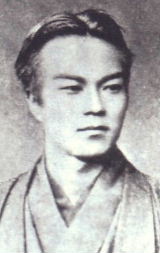 |
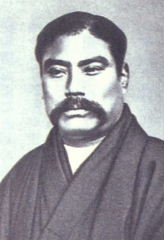 |
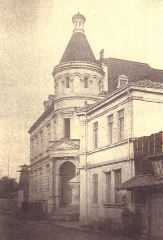 |
| Tomoatsu Godai was a seisho in Western Japan | Yataro Iwasaki, the founder of Mitsubishi Group | Mitsui Trading Company circa 1900 |
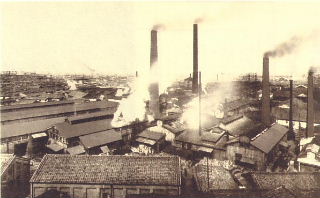 |
|
Sumitomo Copper Refinery in Osaka |
Politically, the establishment of a Western style parliament and a constitution was a nationally shared goal. This was considered absolutely necessary in order to be treated equally by the West. But different opinions over the timing and contents of the proposed constitution caused a lot of political turmoil.
With respect to timing, from 1873 onward, many political groups outside the government demanded a constitution as soon as possible. Political oppositions, intellectuals, and rich farmers joined this Freedom and People's Rights Movement, which sometimes turned violent. Meanwhile, the majority of the top government officials wanted to go slow. They thought the Japanese people were only "semi-developed" and careful preparations were necessary.
As to contents of the constitution, the big debate was whether a British-style democracy and parliamentary system or a less democratic German-style constitutional monarchy should be adopted. Many intellectuals and progressive politicians favored the British system, but conservatists in the government preferred the German model. They feared that if too much freedom was allowed when people's political views were still primitive, violence and instability would result (like the French Revolution and its aftermath).
Under mounting political pressure, Emperor Meiji declared in 1881 that a parliamentary government would be established within 10 years. To study and prepare the contents of the proposed constitution, Minister Hirobumi Ito went to Europe for more than a year to consult German and British legal experts. After returning to Japan, his team drafted a constitution based on the German model while partially incorporating foreign advisors' views (such as Roesler's). The final draft was sent to the Privy Council and debated in intensive closed-door sessions. The Meiji Constitution was promulgated in 1889 and, after an election, the first imperial parliament was convened in 1890. Japan became the first non-Western country with a functioning constitution (outside the West, Turkey also had a constitution but it was short-lived).
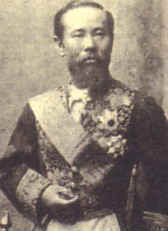 |
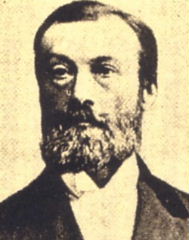 |
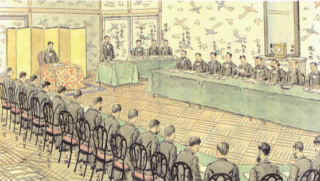 |
| Hirobumi Ito (1841-1909), from Choshu, drafted the Meiji constitution. He also became the first prime minister. | K.F.H.Roesler, legal advisor to the government during 1878-93. He recommended a strong emperor in the German style. | The Privy Council was created to discuss the draft constitution (later became a permanent advisory body reporting directly to the emperor). In this illustration, the emperor himself chairs the session while Ito makes the presentation. |
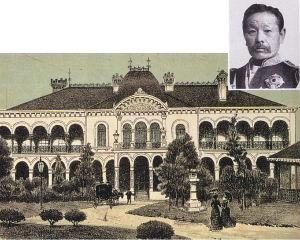 |
|
Foreign Minister Kaoru Inoue hoped to show off Westernized Japan by hosting dance parties at Rokumeikan (built 1883). |
The most important diplomatic goal in Meiji was to revise the unequal treaties with the West, which lacked tariff rights and the right to judge foreign criminals. This was necessary to regain national pride and join the ranks of the "first-class countries." But to succeed, Westernization of the Japanese society was considered necessary. To show that Japan was Westernized, the government even built an official ballroom (Rokumeikan in Hibiya, close to where Imperial Hotel now stands) and invited foreign diplomats for evening balls (which was criticized by nationalists and political oppositions). Gradually, as Japanese modernization proceeded, treaty renegotiation was accomplished. Tariff rights were partially regained in 1899 and completely restored in 1911. The court rights were regained in steps during 1894-99.
Another feature of Meiji foreign policy is expansionism. To protect Japanese independence and interest against Western intervention, it was considered necessary to construct a zone of influence around Japan. The government was eager to "open up" Korea which was maintaining the closed-door policy (as Japan did previously) and conclude an unequal treaty in Japan's favor (just like the West did to Japan). As Korea resisted, in 1873 military invasion was considered but rejected within the government. In the following year, the government sent troops to Taiwan over an incident in which Okinawa fishermen were killed by the Taiwanese. These external expeditions were often planned to deflect the anger of former samurais who were deprived of their privileges and rice salaries.
In the 1880s Japan became more aggressive and tried to place Korea under its influence. Japan's rival was China (Qing Dynasty) which considered Korea as its protectorate. Japan started to intervene in Korea's internal politics and stage military provocation. This eventually led to the Japan-China War in 1894-95.
Soseki Natsume's lecture in 1911Soseki Natsume (1867-1916) is the most popular novelist in Japan. His life largely coincided with the Meiji period. He was an expert in both English and ancient Chinese literature. His early novels were comical ("I am a Cat," "Bocchan") and sometimes romantic ("Sanshiro") or pedantic ("Kusamakura"). But his later novels exposed a dark side of modernized Japan--individuals who struggle with human limitations in modernized life without success ("Sorekara," "Mon"). Desperate love triangles were his favorite theme. The photo shows Soseki at 29 as an English teacher.
Since Japan opened its ports to foreigners, Western impact transformed Japan completely. But all these influences originated in the West, and Japan only copied them passively without really digesting and internalizing them. Arrival of Western waves was too fast, so it was impossible for the Japanese to make them their own. Forced absorption of foreign ideas and systems would make the Japanese nervous and unhappy, but there was no good solution to this problem. That was the essence of Soseki's message (see quotations below). This problem of troubled national identity may still exist in today's Japan. Japan seems uncomfortable in the company of the advanced Western nations, while unable to build true friendship and trust with its Asian neighbors.
|
<References>
Banno, Junji, Nihon Seijishi: Meiji, Taisho, Senzen Showa (History of Japanese Politics: Meiji, Taisho and Prewar Showa), University of the Air Press, revised 1993.
Ishii, K, A. Hara, and H. Takeda, eds. Bakumatsu Ishin Ki, Nihon Keizaishi 1 (End of Bakufu and Meiji Restoration, Economic History of Japan vol.1), Tokyo University Press, 2000.
Iwanami Shoten, Kaiko to Ishin, Nihon Keizaishi 3 (Opening of Ports and Meiji Restoration, Japanese Economic History vol. 3), M. Umemura and Y. Yamamoto, eds, 1989.
Miyamoto, Matao, Nihon no Kindai 11: Kigyokatachi no Chosen (A History of Modern Japan vol.11: Challenges of Entrepreneurs), Chuo Koron Shinsha, 1999.
Shibusawa, Eiichi, The Autobiography of Shibusawa Eiichi: From Peasant to Entrepreneur, translated by Teruko Craig, University of Tokyo Press, 1994.
Toriumi, Yasushi, Nihon no Kindai: Kokumin Kokka no Keisei Hatten to Zasetsu (Modern Japan: The Formation, Development and Collapse of the Nation State), University of the Air Press, 1996.